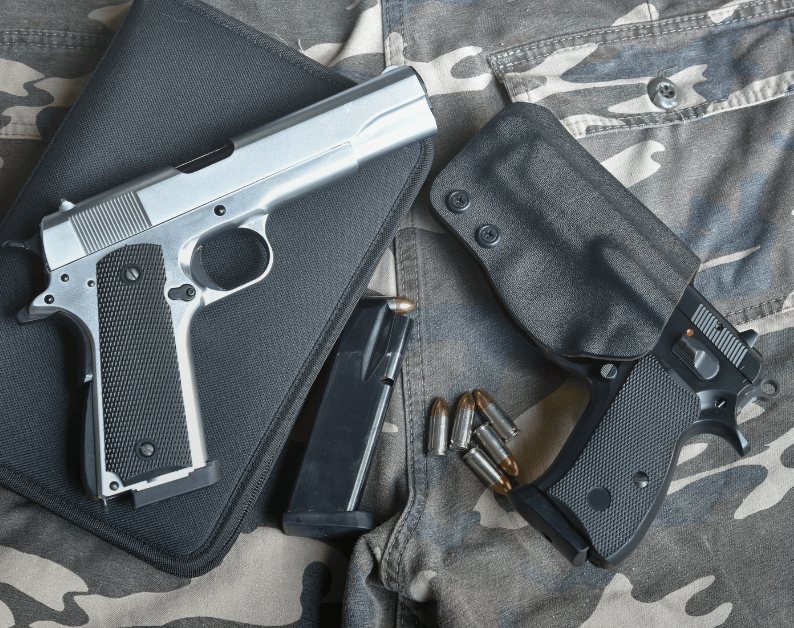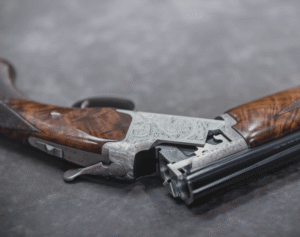New shooters want something safe, simple, and shootable. At Webbs Place, we’ve helped thousands of first-time buyers find handguns they can actually control and practice with. This guide shows you how to pick your first pistol and points you to models that fit.
You’re shopping for your first handgun. Maybe you’ve shot a friend’s pistol once or twice, or maybe you’re starting from scratch. Either way, you want to make a smart choice.
This guide helps first-time buyers who plan to train and practice. We’ll walk you through comparing sizes, calibers, and features. You’ll learn the real differences between revolvers and semi-autos.
The Short Answer
Start with a compact or full-size 9mm semi-auto from a reputable brand. Why? Because 9mm offers broad availability, manageable recoil, and good defensive load performance. Brands like Sig Sauer and Taurus make excellent starter pistols that won’t break your budget.
Safety First (Before You Shop)
Learn and follow the basic rules. Point the firearm in a safe direction. Keep your finger off the trigger until ready. Keep firearms unloaded until you’re ready to use them. These aren’t suggestions; they’re requirements.
Take a basic firearms safety course before you buy. Many ranges offer introductory classes that cover handling, storage, and local laws. Knowledge builds confidence, and confidence prevents accidents.
Decide How You’ll Use It
Think about your primary purpose. Home defense? That points toward larger pistols with higher capacity. Planning to carry concealed now or later? Consider compacts that balance size and shootability. Mostly range training? Full-size models give you the easiest learning curve.
Your intended use guides everything else: size, capacity, sighting features, and even caliber selection. Be honest about what you need versus what looks cool at the gun counter.
Pick A Size You Can Run Well
Full-Size Pistols
These are the easiest to shoot. You get softer recoil, the highest capacity, and a longer sight radius for better accuracy. The downside? They’re harder to conceal if you decide to carry later. Think service pistols like what police carry.
Compact Pistols
Compacts balance shootability and concealment. Most beginners find these the sweet spot. You lose a round or two of capacity compared to full-size but gain versatility. Many models from Taurus and Sig Sauer fit this category perfectly.
Subcompact and Micro Pistols
These are easiest to carry but harder to master. The short sight radius and snappy recoil demand more skill. Consider these after building your fundamentals on something bigger.
Caliber, Simplified
9mm: The Standard Choice
Most new shooters should start here. Ammunition is everywhere, from big box stores to small gun shops. You get good capacity (15-17 rounds in full-size pistols), and modern defensive loads perform well. Recoil stays manageable for most adults.
.380 ACP: Lower Recoil Option
In similar-size pistols, .380 kicks less than 9mm. The trade-off? Generally less performance in gel tests and lower capacity. Good for recoil-sensitive shooters or those with hand strength issues.
Larger Calibers (.45 ACP, 10mm, .40 S&W)
More recoil means slower follow-up shots and longer learning curves. Save these for after you’ve mastered the fundamentals. Yes, they hit harder, but shot placement beats power every time.
What “Good Defensive Ammo” Means
Look for ammunition that reliably penetrates about 12 to 18 inches in calibrated gel. Quality defensive rounds expand properly when needed. Test different brands in your pistol; what runs perfectly in one gun might not in another.
Buy enough to verify reliability (at least 50 rounds), then stock up on what works. Train with similar-weight practice ammo to keep your skills sharp without breaking the bank.
Must-Check Ergonomics
Can you reach the trigger with the pad of your index finger without shifting your grip? Can you run the slide without struggling? Does the magazine release work naturally for your hand size?
These aren’t minor details. Poor ergonomics lead to poor shooting. Dry-fire testing in the store helps, but nothing beats live-fire evaluation. Many ranges rent pistols; try before you buy when possible.
Simplicity And Reliability Over Gimmicks
Striker-fired pistols keep controls simple. Pull the trigger, and the gun fires. No hammers to cock or decock. Manual safeties are optional; some shooters like them, others don’t. What matters is training with whatever you choose.
Skip the laser grips, compensators, and custom triggers for now. Focus on proven reliability. A basic Glock, Smith & Wesson M&P, or Sig Sauer P320 beats a tricked-out pistol that chokes on defensive ammo.
Revolver Or Semi-Auto?
Semi-autos give you higher capacity and easier follow-up shots for most people. Modern designs are reliable and simple to operate. You’ll find more holster options and training focused on semi-auto pistols.
Revolvers offer a simpler manual of arms. No magazines to seat properly, no slides to rack. The trade-offs? Lower capacity (5-6 rounds) and slower reloads. Some shooters with hand strength issues find revolvers easier to manage.
Budget For The Whole Setup
The pistol is maybe half your initial investment. Factor in:
- Practice ammo: 200 to 300 rounds minimum
- Two or three spare magazines
- Quality belt holster if you plan to carry
- Safe storage solution
- Eye and ear protection
- Introductory pistol class
Skipping any of these compromises safety or skill development. Better to buy a less expensive pistol and fund proper training than blow your budget on the gun alone.
Shortlist Starter-Friendly Features
Look for pistols with optic-ready slides or good steel sights. Replaceable backstraps help dial in grip fit. You want proven reliability across different ammo types. Check that holsters and accessories are widely available; obscure models might leave you searching.
Brands like Black Rain Ordnance make quality AR pistols, but these aren’t ideal starter guns. Same goes for AK pistols or derringers. Stick with mainstream defensive pistols for your first purchase.
Range Test Checklist
Can you load, lock, and unload with confidence? Fire slow groups at 7 to 10 yards. How’s your grip comfort? Can you control the trigger smoothly?
Try controlled pairs next. Watch how much the sights rise and how quickly you can get back on target. Run at least 100 rounds without stoppages. Any malfunctions? Figure it out why before buying.
Test your intended defensive ammo too. Some pistols are picky eaters. Better to discover that at the range than when it matters.
Training Next Steps
Schedule a beginner pistol class within two weeks of purchase. Commit to monthly range sessions minimum. Dry-fire practice at home builds trigger control without ammunition costs.
Review safe storage requirements for your situation. Learn your state’s transport laws. Knowledge prevents legal troubles and tragic accidents.



